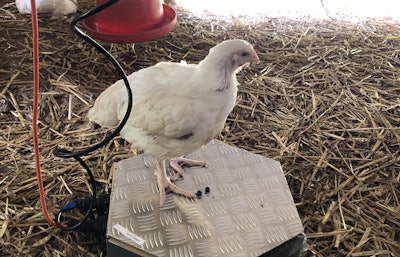
New poultry weight monitoring technology integrates machine learning and algorithms to help track and analyze feed conversion and efficiency.
“Currently, poultry farmers have two methods for calculating mean weight and deviation. The first is via manual weighing, which introduces major inaccuracies due to: limited sampling capacity, non-random sampling and typos during manual data transfers,” explained Giovanni dos Reis Montefiori, founder of Beakbook.
“The second is via a selection of low-tech weighing scales, which are expensive, technologically obscure, unreliable and use inefficient data collection algorithms.”
In addition, manual handling of chickens can be stressful to the birds, impacting their growth performance.
The weight monitoring technology for chickens can increase the amount of weight-data collected by 33-fold, which could result in up to a 7% decrease in production costs through more efficient farm management.
“We have, in early trials, begun to reset the skepticism between poultry farmers and technology, by demonstrating that meaningful cost savings can be made using new technology,” Montefiori added.
Sustainability benefits
More efficient farm management can help improve the sustainability of poultry operations.
“At its highest level, this technology is addressing climate change and therefore creates real benefits for humanity. In order to minimize our resource footprint, a global effort is needed, with novel cross-sector collaborations. Within this context, the technology is supporting farmers, in poultry and beyond, to reduce their resource footprint,” Montefiori said.
More accurate weight monitoring helps farmers make decisions using the most up-to-date information. Forecasting can also allow them to react early to red flags, such as illness, more quickly through forecasting algorithms. This helps maintain high flock well-being by reducing periods of suboptimal growth patterns.
The technology is currently undergoing pilot tests at Japfa’s state-of-the-art farms in Indonesia. Japfa is a major pan-Asian, industrial agricultural and processed food company, producing upwards of 600 million day-old chicks per year.
Like what you just read? Sign up now for free to receive the Poultry Future Newsletter


















